James Maliszewski's Blog, page 65
December 1, 2023
"When I was a little boy ..."
The Limited Pop Cultural Footprint of D&D as a Game
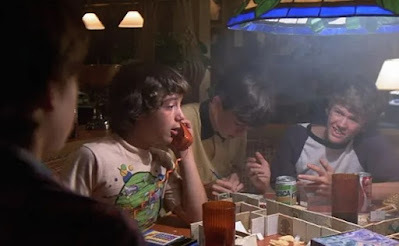 In looking at the early history of Dungeons & Dragons, there's a lot of talk about its faddishness in the late '70s and early '80s. Certainly, news stories about the so-called "steam tunnels incident" of August 1979 catapulted D&D – and roleplaying more generally – to greater public consciousness in the English-speaking world (and perhaps beyond). My own introduction to the hobby was, in part, facilitated by the media hoopla surrounding the disappearance of James Dallas Egbert III. Likewise, I can attest to the fact that, throughout the first half of the 1980s, there were many, many articles written in newspapers and magazines about this "weird new game." I was always on the lookout for them, clipping out the most interesting ones and then transferring them to a big, black binder I acquired for just this purpose.
In looking at the early history of Dungeons & Dragons, there's a lot of talk about its faddishness in the late '70s and early '80s. Certainly, news stories about the so-called "steam tunnels incident" of August 1979 catapulted D&D – and roleplaying more generally – to greater public consciousness in the English-speaking world (and perhaps beyond). My own introduction to the hobby was, in part, facilitated by the media hoopla surrounding the disappearance of James Dallas Egbert III. Likewise, I can attest to the fact that, throughout the first half of the 1980s, there were many, many articles written in newspapers and magazines about this "weird new game." I was always on the lookout for them, clipping out the most interesting ones and then transferring them to a big, black binder I acquired for just this purpose.What's most interesting to me, in retrospect, is how limited the presence of Dungeons & Dragons was in the larger popular culture of the 1980s. Despite the widespread discussion of the game in mass media – including the infamous 1985 60 Minutes hit piece – and its very good sales for TSR, there were almost no pop cultural depictions of kids playing RPGs of any kind during my youth. The only one that comes immediately to mind is that scene during the 1982 Steven Spielberg movie, E.T. the Extra-Terrestrial. There's also the CBS TV movie adaptation of Mazes and Monsters from the same year, but that's far from the kind of thing I'm thinking of. Even the 1983–1985 Saturday morning Dungeons & Dragons cartoon – ironically also broadcast on CBS – doesn't depict any of the characters playing D&D.
Are there any others that I missed? There's the 1985 episode of the BBC Two series, Tucker's Luck, about which I posted earlier this year, I suppose, though I was completely unaware of its existence at the time. I wouldn't be surprised to discover that there are a few other examples of similar things here and there, but, if so, they're not likely to be high profile. Generally, when I think about pop cultural depictions of people playing D&D, they're of much more recent vintage – the mid-90s at the earliest. By this point, D&D and roleplaying games don't appear to have been quite as faddish as they had been a decade previously, if the coverage of the hobby in the news media is any indication.
Why would this be? I'm sure there are many factors involved. The most obvious one to me is that, it wasn't until the mid-1990s that people who grew up actually playing RPGs, were old enough to be in positions within movie and TV studios to depict their youthful hobby. During the fad period of the '80s, I'd wager that most of the people involved in making creative decisions had little awareness and even less understanding of roleplaying games and thus would have no interest in depicting them in the films and programs they were creating. As the first generation of roleplayers aged into adulthood, that started to change.
Of course, even then, the accuracy of these depictions remains spotty at best – and that's being kind. Roleplaying games are notoriously difficult to depict in ways that would be either intelligible or interesting to those unfamiliar with their intricacies. Consequently, we get muddled and misleading depictions of the hobby, often played for laughs, that do little to show off just what it's like to actually play these games. The ironic thing is that, as an entertainment and, dare I say, an art form, roleplaying games, especially Dungeons & Dragons, are among the most pop culturally influential of the last half-century. The video game industry, for example, owes an incalculable debt to RPGs, and it's far from the only cultural industry where RPGs have left their mark. That's why I consider it a shame that, even now, it remains rare to see the play of D&D, as a game, represented in popular culture in a way that properly conveys not just its content but also its enduring appeal.
November 28, 2023
Polyhedron: Issue #12
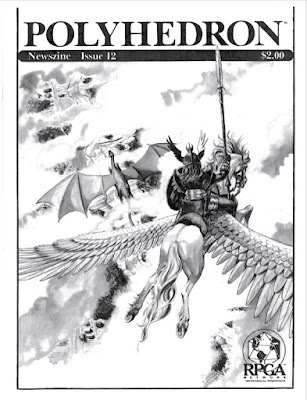 Issue #12 of Polyhedron (June 1983) features a very striking cover by Larry Elmore that depicts a pegasus-riding warrior about to engage a red dragon in aerial combat. Like all of the newszine's recent covers, this one draws inspiration from the issue's installment of "Encounters" about which I'll write shortly.
Issue #12 of Polyhedron (June 1983) features a very striking cover by Larry Elmore that depicts a pegasus-riding warrior about to engage a red dragon in aerial combat. Like all of the newszine's recent covers, this one draws inspiration from the issue's installment of "Encounters" about which I'll write shortly. The issue proper kicks off with an editorial by Kim Eastland – now the publisher of Polyhedron – in which he discusses several matters. The first of these is that Polyhedron has joined TSR's publishing division. I've often called the 'zine "Dragon's little brother" in jest, but, starting with this issue, it's actually somewhat true. Consequently, Mary Kirchoff, who serves as editor, will see her attention divided between Polyhedron and other TSR periodicals. On the other hand, the look and layout of Polyhedron clearly benefitted from this arrangement.Eastland also discusses the many and various meanings of "official" with regards to TSR and the RPGA. That he has to do this at all is painful reading in retrospect, particularly when it comes to the contortions relating to Gary Gygax's columns in Polyhedron and elsewhere. I'm not sure that the fans of any RPG company has ever been as obsessed with "officialdom" as those of TSR, but they clearly were. Sad to say, I was one of them. It's all so silly now, yet, at the time, it seemed oddly important to me and so many others.
The letters page contains one interesting letter and reply, concerning the omission of the Cthulhu and Melnibonean chapters of Deities & Demigods :
 As with all such replies by TSR spokesmen, I'm sure there are additional complexities to be considered. Nonetheless, it's a fairly straightforward and plausible answer to a longstanding and much debated "mystery" of D&D history.
As with all such replies by TSR spokesmen, I'm sure there are additional complexities to be considered. Nonetheless, it's a fairly straightforward and plausible answer to a longstanding and much debated "mystery" of D&D history.This issue sees the appearance of "Two Cents," a new column devoted to RPGA member opinions and suggestions. It's a fine idea for a column, though, if the first installment is any indication, few of the ideas on offer are all that remarkable. Gali Sanchez, a name I most strongly associate with Pacesetter Games, is the author of this issue's "Encounters," featuring Grifton Dunsaway, a human fighter, riding Orrex, a pegasus, as they do battle with Forszahn, a red dragon. Though evocative in concept, there's not much more to the encounter, which is too bad. I very much love the idea of aerial combats in D&D; I've just never seen them handled very well under the rules of the game.
There is a "Convention Update" on RPGA events about which there's little to say. "Dispel Confusion" is three pages in length this time, covering all of TSR's RPGs. The questions cover a wide range of topics, from the ridiculous to the sublime. My favorite question – or, more accurately, response – concerns the lethality of Gamma World, as answered by designer James M. Ward.
GWQ: The GAMMA WORLD game system is so deadly, my players complain that their characters get killed off almost before they have rolled them up! What can I do to help them last long?
GWA: If your characters are constantly dying, they're probably not being very careful. The game was designed to test the intelligence and role-playing skill of everyone who tries their hand.
Ward does go on to offer some genuinely useful advice about how to moderate the game's deadliness for beginners, but I can't help but chuckle at his initial response.
"Basically Speaking" by Jon Pickens takes a look at mass combat in Dungeons & Dragons. It's a topic of long-term interest to me, but, unfortunately Pickens doesn't provide much in the way of concrete guidance on how to integrate large battles into D&D beyond "read some Tony Bath." Good advice, certainly; I guess I'd hoped for more. "Knight Hawks: A New Dimension" by Doug Niles is an overview of the Knight Hawks boxed starship rules set for Star Frontiers. It's mostly a bit of advertising dressed up as an article, alas.
Part III of Frank Mentzer's "Mapping From Square One" continues its focus on how to describe dungeon rooms to players engaged in mapping. It's good stuff and I appreciate the effort Mentzer put into this, even as I realize that, by comparison, my own maps have always been rather straightforward. Mentzer, meanwhile, favors rooms like this:
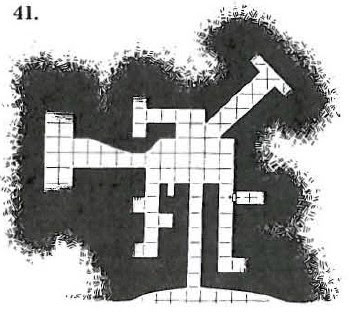 Yikes!
Yikes!Gary Gygax takes over "Notes For the Dungeon Master" this issue, with a very nice two-page discussion of how to create a campaign setting of one's own. Gygax introduces the "bullseye method" of using concentric circles of detail – lots toward the center and less with each "ring" around it, at least to start. Merle Rasmussen's "Roles" looks at the various kinds of agents possible in a Top Secret campaign – double agent, triple agent, mole, blunt instrument, etc. It's too short in length but offers some food for thought nonetheless. The same can't be said about Kim Eastland's continuation of his series on the RPGA tournament scoring system. Perhaps I am unduly harsh and this would have been of interest to RPGA members at the time. Now, it's tedious ephemera of the worst kind.
Leaving aside the RPGA catalog that takes up the final eight pages of the issue, that's it for issue #12.
November 27, 2023
The Logos of TSR's Gamma World
Over the weekend, I was cleaning the bookshelf nearest to my computer desk and saw the boxed sets of the first and second editions of Gamma World sitting side by side. Visually, they couldn't be more different from one another. Here's the logo of the first edition:
 I'm no expert on typography, so I can't tell which font is being used here. I can only say that, whatever it is, the font makes a certain point: Gamma World takes place in a "shattered" setting, one that has suffered some sort of catastrophe that has forever changed it. The logo also seems to imply a connection – thematically or otherwise – to its immediate predecessor RPG, Metamorphosis Alpha.
I'm no expert on typography, so I can't tell which font is being used here. I can only say that, whatever it is, the font makes a certain point: Gamma World takes place in a "shattered" setting, one that has suffered some sort of catastrophe that has forever changed it. The logo also seems to imply a connection – thematically or otherwise – to its immediate predecessor RPG, Metamorphosis Alpha.
 Notice that the word "Alpha" in the title uses the same (or a very similar) font to that fond in Gamma World's logo.
Notice that the word "Alpha" in the title uses the same (or a very similar) font to that fond in Gamma World's logo. By contrast, the second edition of Gamma World sports a very different logo:
 I imagine that the new logo was, first and foremost, born out of a desire by TSR to distinguish the new edition from the old one, so that there could be no confusion between them. Likewise, the new logo has a more modern, even futuristic look to it, which makes sense, given that the game's setting is hundreds of years into our own future. I also can't help but wonder if the new logo was at least partly inspired by the logo used for the two modules and referee's screen released for first edition:
I imagine that the new logo was, first and foremost, born out of a desire by TSR to distinguish the new edition from the old one, so that there could be no confusion between them. Likewise, the new logo has a more modern, even futuristic look to it, which makes sense, given that the game's setting is hundreds of years into our own future. I also can't help but wonder if the new logo was at least partly inspired by the logo used for the two modules and referee's screen released for first edition:
 The similarities between the two logos are small, I'll admit, but they both evoke a similar futuristic vibe, in addition to demonstrating that TSR has more money to devote to graphic design than they did when the first edition was released. That said, I actually prefer the alternate 1e logo to the 2e one. Obviously, TSR didn't feel the same way, since they more or less re-used the latter for the game's third edition.
The similarities between the two logos are small, I'll admit, but they both evoke a similar futuristic vibe, in addition to demonstrating that TSR has more money to devote to graphic design than they did when the first edition was released. That said, I actually prefer the alternate 1e logo to the 2e one. Obviously, TSR didn't feel the same way, since they more or less re-used the latter for the game's third edition.
 Mind you, Gamma World 3e re-used almost all of 2e's art assets, so who knows the logic of this decision? I believe I've read somewhere that 3e was produced during a time of financial uncertainty at TSR (1986), so every effort was made to economize on its production, hence the re-use of so much from the previous edition.
Mind you, Gamma World 3e re-used almost all of 2e's art assets, so who knows the logic of this decision? I believe I've read somewhere that 3e was produced during a time of financial uncertainty at TSR (1986), so every effort was made to economize on its production, hence the re-use of so much from the previous edition.I did not own the game's fourth edition. To this day, I've still never done more than skim a copy of the book, which, as I understand it, had a very mixed reception at the time of its release (1992). The logo shares certain similarities with that of 2e/3e, with an additional whimsical flourish:
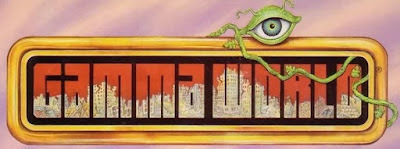 I like the ruined buildings visible inside the letters of the title, but I have mixed feelings about the mutant eye resting on the top, since I think it leans a bit into the "Gamma World is goofy" end of things that I've never liked. That said, I like it nonetheless.
I like the ruined buildings visible inside the letters of the title, but I have mixed feelings about the mutant eye resting on the top, since I think it leans a bit into the "Gamma World is goofy" end of things that I've never liked. That said, I like it nonetheless.
November 26, 2023
In Defense of Evil Characters
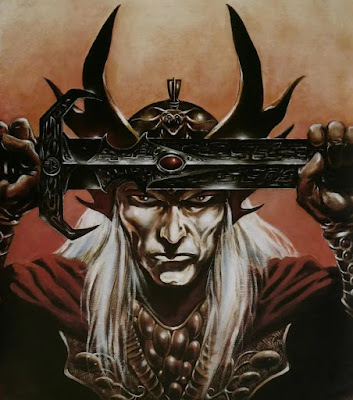 Having last week come to the defense of the murderhobo, I thought I'd go one step further this week by doing something similar for outright evil characters. That's because, for as long as I've played Dungeons & Dragons, I've never considered the possibility of playing such characters illegitimate. None of the editions of the game I encountered in the first few years after I entered the hobby – in order: Holmes Basic, AD&D, or Moldvay Basic – forbids characters from being evil (though the matter is a little complicated in the latter case, since there is no explicitly "evil" alignment). Indeed, all three versions of the game are quite clear that a player character can be of any alignment, including evil ones.
Having last week come to the defense of the murderhobo, I thought I'd go one step further this week by doing something similar for outright evil characters. That's because, for as long as I've played Dungeons & Dragons, I've never considered the possibility of playing such characters illegitimate. None of the editions of the game I encountered in the first few years after I entered the hobby – in order: Holmes Basic, AD&D, or Moldvay Basic – forbids characters from being evil (though the matter is a little complicated in the latter case, since there is no explicitly "evil" alignment). Indeed, all three versions of the game are quite clear that a player character can be of any alignment, including evil ones. Likewise, Holmes states that at least one class – thieves – are "not truly good," while AD&D goes further, claiming that "most thieves tend toward evil." Assassins engage in an activity that Gary Gygax memorably described as "the antithesis of weal," hence their outright restriction to evil alignment. Monks have a very limited range of alignments, but Lawful Evil is among them. Bards are almost as restricted in their alignment options, yet they too can be evil. Only druids, paladins, and rangers are forbidden from being evil by the rules, suggesting that the possibility of a player choosing to play an evil cleric or fighter is in no way beyond the pale.
Of course, it's one thing to see the possibility of evil characters as legitimate and another to see it as desirable. In the early days, I tended to transfer Moldvay's perspective about Chaotic characters to evil ones more broadly: they don't play well with others. For the most part, my friends shared this perspective. I cannot recall anyone of my neighborhood buddies wanting to play an evil character, let alone actually doing so. Like me, they'd come to D&D as relatively innocent boys who looked to the heroes of mythology and literature for inspiration in generating our earliest characters. Few, if any, of these characters were evil either in thought or deed and our own characters reflected this.
However, as I mentioned in my post about murderhobos, a number of the protagonists of the pulp fantasy stories that served as the inspiration of Gary Gygax in his personal conception of the game were, at best, morally ambiguous and, in a few cases, evil by the standards of D&D's alignment system. That this is the case is made unmistakable in, for example, the write-up of Elric in Deities & Demigods, which judges him Chaotic Evil in alignment. One can certainly argue the fine details of that or similar judgments, but there's no denying that there's a strong tradition of pulp fantasy characters whose exploits include a lot of morally dubious actions.
Beyond that, one need only take a look at the play of the earliest Dungeons & Dragons campaigns. Blackmoor, the birthplace of D&D, featured at least one significant evil player character – Sir Fang, a fighter-turned-vampire whose depredations proved so frightful to the other characters in that campaign that the cleric class was created to stand against him. Meanwhile, one of the most successful characters in Gygax's Greyhawk campaign was Robilar, played by Rob Kuntz. Robilar was not unique in this regard. A quick look at The Rogues Gallery reveals a number of evil-aligned player characters among TSR's writers and designers. If you look at the pregenerated characters for use with modules like Expedition to the Barrier Peaks and Dwellers of the Forbidden City, you'll find several also have evil alignments.
The weight of all this evidence was still insufficient to turn me into a defender of evil characters, except in the narrowest sense. Yes, the rules allow for evil characters, but that didn't mean I had to like it. What ultimately changed my mind was when, many years after I first played D&D, I participated in several sessions that featured an evil character. He was a Neutral Evil psionicist/thief – this was in the days of 2e – and he made himself very useful to his companions by both his skills and his knowledge. I never completely trusted him, but there was no denying that he filled a niche in the party and that his presence helped us succeed when we might otherwise have not. It helped, too, that he was well roleplayed as a charming, if not at all trustworthy, rascal.
Ultimately, that's what convinced me that an evil character could be fun: good roleplaying. Here was a completely disreputable character, a liar and a cheat, whose actions were almost never self-interested – but he was played so well and so enjoyably that I almost forgot he was evil. Eventually, the character had the opportunity to betray his comrades to his benefit and he took it. The betrayal left us in a bit of a bind and, while my character was certainly angry, I was not. The character acted as he ought to have, given his alignment. If anyone is to be blamed, it's the rest of us for taking on such a character, knowing as we did that he was evil. But, as I said, he was charming, so fun, that we let our guard down and paid the price for it.
That may seem an odd defense of evil characters. From my perspective, though, it's the strongest one I can offer: sometimes it's fun. Roleplaying games are a form of escapism, something I consider very important, especially nowadays. Having a creative outlet for our baser instincts is, in my opinion, just as vital as having one where we can behave heroically. Sometimes we want to be Galahad and sometimes we want to be Cugel the Clever. I don't see either one as inherently better than the other. While my preference remains for less morally compromised characters, I can easily see the fun in evil characters. Arguably, many of the characters in my House of Worms campaign would be considered evil in D&D terms, so it's not as if the playstyle is completely outside my taste. I've also long harbored a desire to a referee a D&D campaign in which all the characters are members of a Thieves' Guild. In such a campaign, I suspect the vast majority of the characters would be evil, or at least non-good.
I'd love to know of your experiences playing or playing with evil characters. Is it enjoyable? Is it something you'd recommend? What are the advantages and drawbacks of this kind of game? It's a topic that I think deserves greater examination.
November 21, 2023
Polyhedron: Issue #11
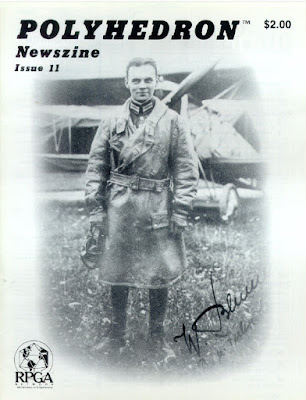 Issue #11 of Polyhedron (April 1983) is another whose cover I remember well, because, unlike all of its predecessors, it features a historical photograph of a World War I German pilot. I've long been a sucker for this sort of thing, since it brings the past alive in a way that no drawing or painting, no matter how well executed, can ever hope to do. In this case, the photo is meant to complement the issue's "Encounters" article by Mike Carr, which outlines a scenario for
Dawn Patrol
, in which German and British dogfighters face off against each other.
Issue #11 of Polyhedron (April 1983) is another whose cover I remember well, because, unlike all of its predecessors, it features a historical photograph of a World War I German pilot. I've long been a sucker for this sort of thing, since it brings the past alive in a way that no drawing or painting, no matter how well executed, can ever hope to do. In this case, the photo is meant to complement the issue's "Encounters" article by Mike Carr, which outlines a scenario for
Dawn Patrol
, in which German and British dogfighters face off against each other."Notes from HQ" focuses not on RPGA ephemera but on TSR. The column's author, Kim Eastland, begins by unveiling the company's new logo:
 Though my personal affections lie with TSR's earlier Game Wizards logo – the depicting the silhouette of a wizard – there's no denying that this 1983 logo was both memorable and long-lasting, being used well into the AD&D 2e era. Eastland explains that the logo is intended to "resemble a maze in structure (which credits TSR's first love – FRPG's)." The remainder of "Notes from HQ" is devoted to announcing the imminent release of various products for most of its RPGs, as well as Endless Quest books and miniature figures.
Though my personal affections lie with TSR's earlier Game Wizards logo – the depicting the silhouette of a wizard – there's no denying that this 1983 logo was both memorable and long-lasting, being used well into the AD&D 2e era. Eastland explains that the logo is intended to "resemble a maze in structure (which credits TSR's first love – FRPG's)." The remainder of "Notes from HQ" is devoted to announcing the imminent release of various products for most of its RPGs, as well as Endless Quest books and miniature figures.The letters page fills two pages and begins with the following:
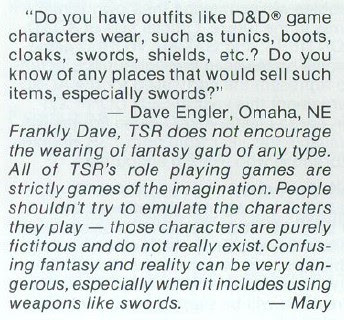 I can't help but wonder whether Mary Kirchoff's strongly negative response was reflective of TSR's official policy and was itself a hedge against unhinged criticisms of D&D that were starting to gain traction in certain circles. Also included is a letter from pre-Dragon Roger E. Moore and a plea to publish the ages of RPGA members appearing in its directory. The letter writer is an adult and has found that almost all the members in his area are children – further evidence perhaps of the extent to which TSR's efforts to expand the hobby to younger people was, in fact, successful.
I can't help but wonder whether Mary Kirchoff's strongly negative response was reflective of TSR's official policy and was itself a hedge against unhinged criticisms of D&D that were starting to gain traction in certain circles. Also included is a letter from pre-Dragon Roger E. Moore and a plea to publish the ages of RPGA members appearing in its directory. The letter writer is an adult and has found that almost all the members in his area are children – further evidence perhaps of the extent to which TSR's efforts to expand the hobby to younger people was, in fact, successful.Mary Kirchoff's "The Allegory of the Pary" is a bit of humorous fiction intended to broach the subject of "problem players," by which she means those whose actions "impair a role playing game, both in the playing atmosphere they create, and how far the party or campaign progresses." Re-reading this article now is a bit of serendipity, given my musings about so-called murderhobos yesterday. Articles like this are a reminder that I've been very fortunate over the years in playing with friends who've (broadly) been on the same page as I with regards to what I want out of roleplaying. If Kirchoff's fiction is any indication, not everyone is so lucky.
"Getting Started" by Mike Carr is another Dawn Patrol article, this time presenting some very basic thoughts on how to introduce players to the game. I wish I could say there was any deep wisdom here that I haven't read many times before, but I cannot. That's no knock against the article; it's simply evidence that I've been at this a long time. "Dispel Confusion" once again answers questions about the D&D, AD&D, Boot Hill, Dawn Patrol, Gamma World, Gangbusters, Star Frontiers, and Top Secret games. As is often the case, none of the questions is worthy of extended comment. However, I do find it interesting that, in response to a D&D question, Frank Mentzer reiterates that D&D and AD&D are "different game[s]," adding emphatically "Don't mix the two!"
Mentzer's "Notes for the Dungeon Master" continues the discussion of deities begun last issue. As before, his concern is dealing with reports of high-level player characters slaying gods and demigods, something he deems not only impossible but also unwise within the context of the campaign. Part II of Mentzer's "Mapping from Square One" is, I have to admit, rather tedious. He goes on at length, presenting a wide variety of corridor types, how they differ from another, and how they should be described. Here's the accompanying illustration:
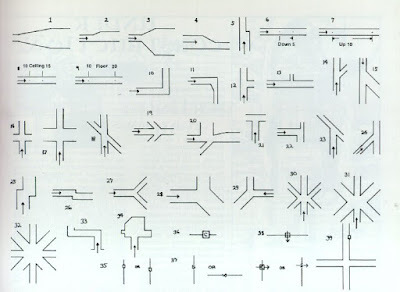 As I said about Part I of this series, I appreciate what Mentzer is trying to do here. My main concern is that, in his effort to cover all the bases, he may be undermining its utility to its intended audience of neophyte cartographers.
As I said about Part I of this series, I appreciate what Mentzer is trying to do here. My main concern is that, in his effort to cover all the bases, he may be undermining its utility to its intended audience of neophyte cartographers.James M. Ward's "Under Construction" presents a new locale for Gamma World: a crashed shuttle from an orbital research station now overgrown with alien fungus. It's a fun little mini-dungeon concept and I must admit I've repurposed versions of it in various games I've run over the years. Frank Mentzer's "Spelling Bee" tackles druid spells and their overlooked uses.
"Escalation and Blackmail" is a very strange, two-page article by Gary Gygax. In it, he addresses two related concerns about the play of AD&D. The first concerns the first part of the title, namely characters who achieve high level too quickly and/or easily. Gygax claims that it should be uncommon for characters in a properly refereed AD&D campaign to reach 20th level. By "properly refereed," he means following all the game's rules as written and adjudicated by "superior DM's" (his words). The second concern related to players who coerce and bully their DM to give them what they want without regard for either the rules or the health of the campaign. As I said, it's a very peculiar article. Gygax suggests at the start of the article that he's addressing problems brought to his attention about behavior in the RPGA. Since I never participated in any RPGA activities, I can't say how widespread they might have been. Was it really bad enough to warrant this sort of pontifical denunciation?
There's a second part of the "Tournament Scoring System" that I must admit I simply could not read. More interesting were the reviews of the two Mattel electronic D&D games: the Computer Fantasy Game and the Computer Labyrinth Game. The reviews are predictably positive, but I am willing to overlook that, owing to my own weird fondness for both games. Neither one is good by any reasonable definition. However, I played them extensively upon their release and had fun with them despite their flaws. There's nothing wrong with a dose of nostalgia now and again.
Issue #11 continues Polyhedron's evolution toward something more akin to a proper gaming magazine. It's still very focused on RPGA matters, which is understandable, given its origins, but the number of articles of general interest to players and referees of TSR's RPGs is increasing. That's why I remained a subscriber for so long and why I look forward to re-reading future issues.
November 20, 2023
The Ten Commandments of D&D
Issue #81 (September/October 1977) of Campaign magazine is notable for its lengthy overview/review of Dungeons & Dragons, written by Len Kanterman (of Starships & Spacemen fame) and Charles Elsden. The entire article is worthy of extended examination – and I plan to do just that over the course of several upcoming posts – but I thought a section toward the end might elicit some commentary. Dubbed the "ten commandments of D&D," they represent the authors' advice to traditional wargamers playing the game for the first time.
 All told, it's not bad advice, though most of it consists of maxims long-time players have no doubt heard variations of for years. I'm immediately struck by two things. First, much of the advice concerns combat and the best way to survive it – no surprise, I suppose, given both the likely audience of Campaign and the nature of D&D gameplay. Second, the specter of the Killer DM looms large here or at least the idea that surviving a D&D session is difficult and it'll take ingenuity and the wise marshalling of a character's limited resources to achieve it.
All told, it's not bad advice, though most of it consists of maxims long-time players have no doubt heard variations of for years. I'm immediately struck by two things. First, much of the advice concerns combat and the best way to survive it – no surprise, I suppose, given both the likely audience of Campaign and the nature of D&D gameplay. Second, the specter of the Killer DM looms large here or at least the idea that surviving a D&D session is difficult and it'll take ingenuity and the wise marshalling of a character's limited resources to achieve it. What stood out to you?
Monsoon Season
Tom Wham is underappreciated in my opinion. Here's his "Gamesmanship" comic from issue #81 (September/October 1977) of Campaign magazine.
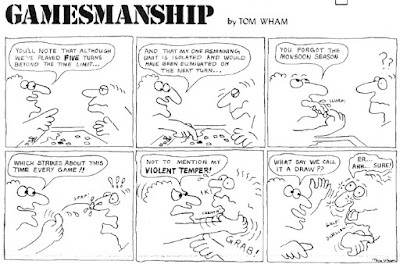
November 19, 2023
In Defense of the Murderhobo
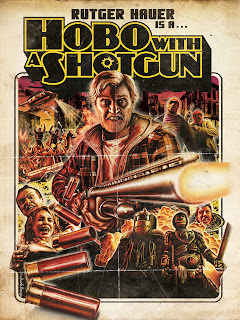 Like any hobby, roleplaying games are replete with their own unique vocabulary and jargon. Spend any time with someone deeply invested in roleplaying and odds are good you'll soon encounter one or more words whose meaning would be impenetrable to outsiders. Even the title of this blog has its origins in RPG – and, before that, wargaming – argot that would make little or no sense to the average person.
Like any hobby, roleplaying games are replete with their own unique vocabulary and jargon. Spend any time with someone deeply invested in roleplaying and odds are good you'll soon encounter one or more words whose meaning would be impenetrable to outsiders. Even the title of this blog has its origins in RPG – and, before that, wargaming – argot that would make little or no sense to the average person. Occasionally, even someone who's been playing roleplaying games for as long as I have will come across a term whose meaning is unclear. Such is the case with "murderhobo," a word whose origins, I assumed, must be relatively recent, since it's not one with which I was familiar. A quick search online reveals that "recent" in this case is relative, since "murderhobo" has been commonplace in online discussions of Dungeons & Dragons for more than a decade now. Color me surprised!
Like "grognard" and "killer DM," "murderhobo" seems to have mostly negative associations. What interests me, as I delved more deeply into this, is how the term seems to have evolved since its initial coinage. At the start, the term appears to have been a partly affectionate jab at the style of play that some claim was the default at the dawn of the hobby: rootless wanderers employing violence to enrich themselves.
 DCC RPG has made murderhoboism its brandThis post is not the place to rehash arguments for or against how people in the early days actually played RPGs. For our present purposes, all that matters is that plenty of people not only believe that the first gamers played games in this way but also that this style of play is, at best, laughable and, at worst, objectionable. Despite the contemporary origins of the term, this censorious attitude toward murderhoboism isn't limited to players of more recent vintage. Even within the old school realm, deprecation of the murderhobo is far from unknown.
DCC RPG has made murderhoboism its brandThis post is not the place to rehash arguments for or against how people in the early days actually played RPGs. For our present purposes, all that matters is that plenty of people not only believe that the first gamers played games in this way but also that this style of play is, at best, laughable and, at worst, objectionable. Despite the contemporary origins of the term, this censorious attitude toward murderhoboism isn't limited to players of more recent vintage. Even within the old school realm, deprecation of the murderhobo is far from unknown.That having been said, there is a criticism of murderhoboism that does seem to originate among newer gamers. This criticism focuses on the way that murderhobo characters can derail a referee's carefully constructed campaign. Their acts of random violence represent an unwillingness to commit fully to the "story" the referee is attempting to tell and is thus worthy of rebuke. While I am generally quite dismissive of referees who mistakenly think it's their job to tell a story, I am nevertheless mildly sympathetic to any referee who has to deal with needlessly disruptive players.
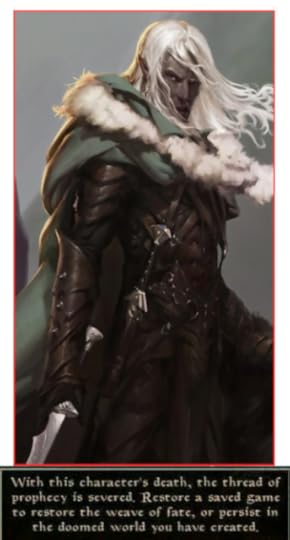 Note the adverb: needlessly. Sometimes, players are disruptive for a very good reason. I have personally been involved in sessions where my fellow players decided to barricade a tavern and then burn it down, its patrons still inside, as an act of rebellion against the referee, whose heavy-handed plot they could no longer stand. They were, according to this second understanding of the term, murderhobos, because they derailed the referee's game with their violent antics.
Note the adverb: needlessly. Sometimes, players are disruptive for a very good reason. I have personally been involved in sessions where my fellow players decided to barricade a tavern and then burn it down, its patrons still inside, as an act of rebellion against the referee, whose heavy-handed plot they could no longer stand. They were, according to this second understanding of the term, murderhobos, because they derailed the referee's game with their violent antics.I'm afraid I don't have much time for the first criticism of murderhoboism. Most of the protagonists of the pulp fantasy stories that inspired Arneson and Gygax could probably be called murderhobos, in at least some of their adventures. I find it difficult to look askance at any player inspired by Conan, Fafhrd, or the Gray Mouse – never mind Elric, many of whose yarns begin and/or end with random acts of violence on his part. Certainly, this isn't the only way to play Dungeons & Dragons, nor even my preferred one, but I don't see anything wrong with it and indeed know firsthand that it can be quite fun. Like so many things, I think what's really needed is not so much disdain for so-called murderhoboism as clearer agreement between players and the referee about the kind of game they wish to play.
I've already addressed the narrow sense in which I can give credence to the second type of criticism. That said, I have very little patience for referees who want, above all, to "tell a story," more specifically their story. One of my strongest beliefs about roleplaying is that it is a collaborative entertainment, where the wishes of neither the referee nor the players are supreme. Consequently, "story" is, at best, an emergent property recognizable only after the fact, an attempt to make sense of the unexpected twists and turns arising from the interactions of all involved and the randomness of dice rolls. Anyone who places his own prefabricated narrative above the glorious riot of player choice (even stupid choice) deserves to be terrorized by murderhobos.
In the end, I'm not sure murderhobos need defending, so much as understanding of what they are and why someone might wish to play D&D (or any other RPG) in that style. Mind you, I think that's the case with nearly every style in which one might play, but what do I know?
November 15, 2023
A Mystery Solved?
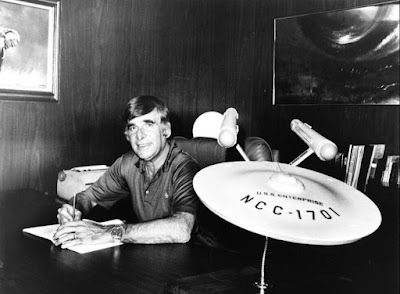 Being a Star Trek fan, I was aware of the fact that, sometime during the early stages of the production of 1979's Star Trek: The Motion Picture, the original 33-inch model of the U.S.S. Enterprise (used in the title sequence of the television show) had become lost. Gene Roddenberry had a sentimental attachment to the model and was keen to get it back, but, despite his best efforts, he was never able to do so. Its disappearance was thus one of big mysteries of Star Trek lore – that is, until the end of last month.
Being a Star Trek fan, I was aware of the fact that, sometime during the early stages of the production of 1979's Star Trek: The Motion Picture, the original 33-inch model of the U.S.S. Enterprise (used in the title sequence of the television show) had become lost. Gene Roddenberry had a sentimental attachment to the model and was keen to get it back, but, despite his best efforts, he was never able to do so. Its disappearance was thus one of big mysteries of Star Trek lore – that is, until the end of last month.According to this article, a listing on eBay for a replica of the Enterprise caught the eyes of some fans, who suspected that it might well have been the model missing for nearly half a century. They contacted the seller with their suspicions, recommending he get in touch with Roddenberry's family about it. Soon thereafter, Roddenberry's son, Rod, issued the following statement:
“Along with much of the Star Trek community, I was excited and pleased to learn that the original 3-foot filming model of the Starship Enterprise appears to have been discovered after being missing for decades (pending full authentication). I can confirm that I am now, through an intermediary, in contact with the individual who possesses the model.
This prototype played a key role in the visualizing design of the famous television starship during Star Trek’s early development in 1964. Once the show went into production, the model was actually filmed in numerous visual effects shots seen throughout the life of the original Star Trek series, along with a larger, 12-foot model that is currently displayed at the Smithsonian National Air and Space Museum. I am convinced that this prototype model holds immense significance for Star Trek and its 58-year history. From its creation in the mid-60s until about 1977, the model was in the possession of my father, Star Trek creator Gene Roddenberry. Unfortunately, it went missing after being loaned out during the production of Star Trek: The Motion Picture.
Beyond its physical value, the greater significance is this prototype Enterprise model really represents the underpinning ideas my father imbued into the series. That we are clever, resilient and can learn from our mistakes. We can and will move beyond archaic belief systems. And once we truly embrace the infinite diversity all around us, both in form and idea, we will then take those next step into a prosperous and unlimited future.
Guided by this principle, one of my primary goals over the past decade has been to locate, recover, and digitally archive significant Star Trek materials and artifacts through the Roddenberry Archive project. The intention would be to scan it in the finest detail for the Roddenberry Archives and after rigorous scrutiny make it available to the public. Furthermore, I firmly believe that a piece of such importance should not be confined to any private collection. This iconic artifact should be enshrined along side the 12-foot shooting model at the Smithsonian’s National Air and Space Museum, where it can serve to help tell the story of television history, the history of space exploration and ultimately, a beacon of hope for the future.”
I'm quite curious to see how this story plays out. Growing up in Maryland, I regularly visited the National Air and Space Museum in Washington, D.C. A highlight of any such trip was seeing the 11-foot studio model of the Enterprise used for exterior shots in the 1960s TV series. Consequently, this story really piqued my interest. I imagine many of my readers will feel the same way.
James Maliszewski's Blog
- James Maliszewski's profile
- 3 followers




